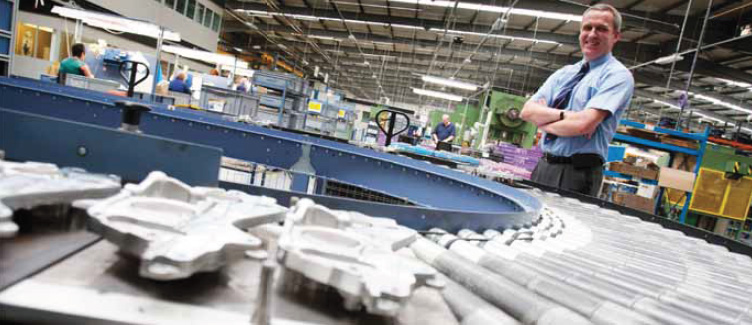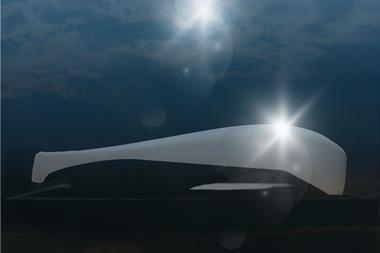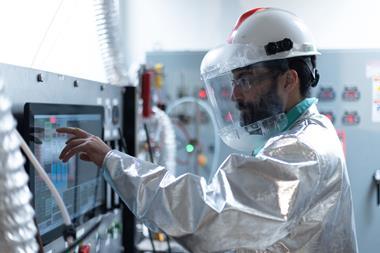
Using adhesives for body manufacture – adhesives which can be formulated for aluminium, steel and composite bonding applications on unprepared surfaces – is a trend that’s on the rise with automakers,” sums up Jeff Kapp, a structural adhesives specialist within 3M’s automotive division. “Some manufacturers have been reporting up to a 50% increase in use,” he adds. German automotive adhesives specialist Dürr Systems has recently seen adhesive use rising by 15-20% per year, says Ralf Ludwig, vice-president of Dürr’s application technology division, who points to advances in adhesive science and the technology deployed in applying it on the production line. And it is not difficult to see why adhesives are enjoying such growth. Take weight saving, for instance: by introducing crash-resistant adhesives between the seams of core structure panels, the thickness of the steel used for the panels can be reduced, points out Kapp.
When it comes to optimising power to weight ratios, a 1,000 mph (1,610km/h) vehicle targeting the world land speed record needs all the help it can get.
In terms of the ‘power’ part of the equation, the media has tended to focus on the brand-name motive muscle behind the Bloodhound SSC (SuperSonic Car), which will be driven – or should that be piloted? – by former RAF Wing Commander Andy Green sometime in 2013.
Powered by a rocket bolted to a Eurofighter Typhoon jet engine, the car’s Cosworth F1 engine isn’t there to turn the wheels, but instead drive the pump that supplies the rocket with concentrated hydrogen peroxide.
But look at the ‘weight’ part of the ratio, and you’ll find a brand name that’s less familiar to the general public, but very well known to aerospace engineers: Sil Mid, which is supplying Redux 322 fi lm adhesive to the Bloodhound SSC project. The vehicle’s lower chassis is made up of aluminium bulkheads and steel which will be bonded and riveted together. As part of the trials to determine the best adhesive to use alongside riveting the chassis, the team needed to explore performance at high temperatures, taking into consideration safety, weight, fatigue and vibration.
The structural adhesive bond had to be achieved and maintained over a range of temperatures up to 150°C with high vibration loads, retaining its strength characteristics for the duration of the challenge. Controlled and managed tests were carried out, identifying Redux 322 as the adhesive of choice, owing to its consistent data spread across all temperatures.
A hot melt film, Redux 322 is a high performance modified epoxy adhesive curing at 175°C, suitable for bonding metal-to-metal and sandwich structures, where operating temperatures are experienced up to 220°C for short periods, or 200°C for continuous operation. “Fasteners are poor in fatigue and vibration, whereas the adhesive spreads the load over the whole joint, increasing local stiffness and fatigue resistance,” sums up Dr Ewen Kellar of Cambridge-based engineering consultants TWI, which carried out the test. “The adhesive takes the full load of the joint in service, the rivets being a second line of defence. It is a combination which explains why such joints are used in cars for impact protection.”
“Because the adhesive allows stress to be more efficiently transferred between panels, it helps boost body stiffness while maintaining crash performance,” he says. “By using structural adhesives and reducing steel thickness, automakers can save around 5kg weight per vehicle for every 34m of adhesive used.”
What’s more, the use of adhesives also can help to eliminate reinforcements in joint design, further reducing weight, he adds. “Using an adhesive helps to spread the load across the joint, eliminating the need for additional reinforcements,” says Kapp. “Assuming an average reinforcement weighs 0.4kg, eliminating just two equals a weight saving of 0.8kg alone.”
Another advantage is that adhesives can be used to join dissimilar materials – aluminium and steel, for instance, or steel and composite combinations – where welding cannot be used. At German automotive component supplier Oehme, aluminium panels for Evobus buses are reinforced in an adhesive assembly process, with two component adhesives applied during a fully automatic process by a six-axis robot with two supplementary axes.
Indeed, points out Kapp’s colleague Abs Master, 3M’s global business development manager for structural adhesives in the automotive sector, the ability to effectively join plastic and composites to steel panels has provided a considerable fillip to the use of such materials – further contributing to weight-saving. Similarly, an improved NVH performance means that fewer additional NVH materials need adding to a vehicle build, further reducing weight. What’s more, notes Master, adhesives offer advantages in strength over joining technologies such as fasteners – often delivering superior performance for similar or lower weight. “With fasteners, when one fails, all the stress moves to the next fastener and when that fails, to the next, and so on,” he points out. “Adhesives spread the stress more evenly.” Recent trends in adhesive application have applied this to advances in joint design, designing-in to vehicle joints intended to improve crash worthiness by crumpling and failing in an ever more predictable manner.
Sticky times
So, it would seem the time for adhesives has definitely arrived but, notes Bob Orme, senior technology specialist for the automotive sector at adhesives giant Henkel, the use of adhesives in automotive manufacture isn’t new. In powertrain manufacture – a particular speciality of Orme’s – sealants and adhesives have been used since the 1960s and 1970s, he notes.
with a fibrous gasket sealed with something like hermetite will leak oil as the vehicle flexes under load,” he points out. “1970s engines, using the same block design, but with a liquid gasket, will leak a lot less. In the 1980s, our mission was to make old designs better. But from the 1990s onwards, the thrust, in terms of adhesives, has been about getting involved in new designs – such as the Rover K-series, one of the first applications of ‘designed-in’ liquid gaskets.” Even today, new advances are being made – and not necessarily solely by the adhesives industry. Specialty automotive heat shield and gaskets supplier ElringKlinger (GB) has recently invested £250,000 into the in-house development of a fully automated Cured In Place (CIP) technology production line, intended to seal automotive parts and replace the traditional metal gasket. “The use of CIP is growing rapidly, since it is advantageous in terms of high precision, saving energy, space and reducing waste,” says Mike Swankie, engineering manager at ElringKlinger (GB). “It achieves high productivity and is an ideal low-cost solution for volume production.”
Currently used to produce high-quality BMW engine castings via the application of a rubberised liquid, the prototype was developed in the firm’s R&D department, where engineers adapted a robot dispensing unit for the sealant, applying it through a high pressure nozzle at an accuracy of 100 microns high and 4mm wide, with a control tolerance of +/ 25 microns. The technology took three months to fully develop and install, says Swankie, and takes up just 64 square metres of space. Operating using tunnel oven elements to heat the castings to 115ºC, it is in operation eight hours a day, producing 200,000 units a year for BMW’s Mini – on average 840 sealed engine castings daily, passing along the line every 30 seconds as part of a seven-minute cycle time.
Body strength
But it’s in BIW construction where the impact of adhesives has arguably been the greatest, with statistics from 3M indicating latest-model usage increases of 200% or more compared to the average usage of prior models. “It began peripherally, with stiffening-to-skin bonding on parts like bonnets and door skins: the amount of adhesive is very small, but because the surface area is large, the impact on flutter is enormous,” explains Henkel’s Orme. “Now, it’s metal-to-metal in a variety of combinations, and epoxy adhesive foam-filled box sections to deliver strength and rigidity, where the curing takes place as the sections go through the paint oven.”
That said, points out Dürr’s Ludwig, paint oven curing – while technically ‘free’ – isn’t the sole curing choice on offer. Some manufacturers, he explains, apply induction or infrared curing within the body shop, prior to the paint oven. The precise option selected, he explains, depends partly on the substrate, and partly on the manufacturer’s preferences. “With ‘high end’ applications – especially with few weld points – the decision will be to apply in-line infra-red or induction curing to provide acceptable strength levels for handling,” he notes. “Where strength requirements on used adhesives are lower, direct in-line induction curing is commonplace, not least because it’s easiest and quicker. But in both cases, the real baking is done in the paint oven.”
Better application
Advances in application technology, too, are adding to adhesives’ appeal. Dürr’s conventional electrically-driven robotic dosers are being augmented by ‘short bead’ application guns, delivering a reduction in the amount of adhesive required of up to 30%, along with high levels of accuracy and reproducibility and a reduced cycle time. Better still, the so-called ‘burnt shell’ problem is eliminated, by applying adhesive only in areas where subsequent spot welding won’t then burn the semi-cured adhesive – neatly delivering a quality improvement as well as a reduction in material consumption.
Roll it all together, in short, and the use of adhesives – especially in BIW – would seem to have a very promising future.






































